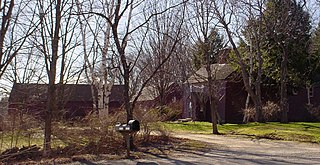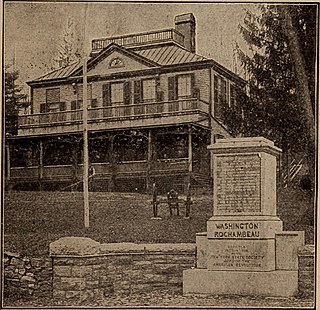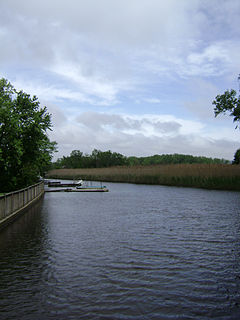
Wappingers Falls, officially the Village of Wappingers Falls, is a village in Dutchess County, New York, United States. As of the 2010 census it had a population of 5,522. The community was named for the cascade in Wappinger Creek. The Wappingers Falls Post Office covers the towns of Wappinger, Poughkeepsie, Fishkill, East Fishkill, and LaGrange.

Piermont is a village incorporated in 1847 in Rockland County, New York, United States. Piermont is in the town of Orangetown, located north of the hamlet of Palisades, east of Sparkill, and south of Grand View-on-Hudson, on the west bank of the Hudson River. The population was 2,510 at the 2010 census. Woody Allen set The Purple Rose of Cairo, a fictional film within The Purple Rose of Cairo (1984) in Piermont.

Ridgewood is a neighborhood in the New York City borough of Queens. It borders the neighborhoods of Maspeth, Middle Village and Glendale, as well as the Brooklyn neighborhoods of Bushwick and East Williamsburg. Historically, the neighborhood straddled the Queens-Brooklyn boundary.

Buffalo City Hall is the seat for municipal government in the City of Buffalo, New York. Located at 65 Niagara Square, the 32-story Art Deco building was completed in 1931 by Dietel, Wade & Jones.

Old Fort Johnson is a historic house museum and historic site at 2 Mergner Road in Fort Johnson, New York. It is the site of Fort Johnson, a two-story stone house originally enclosed in fortifications built by Sir William Johnson about 1749. The fort served as Johnson's home, business office and trading center until 1763 when he moved to Johnson Hall in what is now Johnstown, New York. Sir William's son Sir John Johnson owned the house from 1763 until 1776, when it was confiscated by the local Committee of Safety. The house remains and is owned and operated as a museum by the Montgomery County Historical Society. It was designated a National Historic Landmark in 1972.

Charles A. Lindbergh State Park is a 569-acre (2.3 km²) Minnesota state park on the outskirts of Little Falls. The park was once the farm of Congressman Charles August Lindbergh and his son Charles Lindbergh, the famous aviator. Their restored 1906 house and two other farm buildings are within the park boundaries. The house, a National Historic Landmark, and an adjacent museum are operated by the Minnesota Historical Society, known as the Charles Lindbergh House and Museum. Three buildings and three structures built by the Works Progress Administration in the 1930s were named to the National Register of Historic Places. These buildings include a picnic shelter and a water tower, built in the Rustic Style from local stone and logs, and have remained relatively unchanged since construction. Although the property includes shoreline on the Mississippi River, the Lindbergh family requested that the park not include intensive use areas for swimming or camping, so development was kept to a minimum.

The Bronck House, also known as the Pieter Bronck House, is a historic house museum west of Coxsackie in Greene County, New York. With a construction history dating to 1663, it is believed to be the oldest surviving building in Upstate New York, and is a well-preserved example of early Dutch and Swedish Colonial architecture. It was declared a National Historic Landmark in 1967. It is now a museum property managed by the county historical society.

The Elizabeth Cady Stanton House is a historic house at 32 Washington Street in the village of Seneca Falls, New York. Built before 1830, it was the home of suffragist Elizabeth Cady Stanton (1815-1902) from 1847 to 1862. It is now a historic house museum as part of Women's Rights National Historical Park. It was declared a National Historic Landmark in 1965.

The John Sedgley Homestead is a historic homestead property at Scituate and Chases Pond Road in the York Corner area of York, Maine. Its oldest structure built in the late First Period, probably c. 1715, it is the oldest homestead in the State of Maine that is still in its original setting. Historically the homestead included a cape, farm home, carriage house, stables building, two outbuildings, and a large land holding, all of which is still existing today. The property was listed on the National Register of Historic Places in 1976.

The Main Street Historic District is one of two such districts in the village of Roslyn, New York. It is, as its name suggests, located along Main Street between North Hempstead Turnpike and East Broadway, incorporating Tower Street and portions of Glen Avenue and Paper Mill Road.

The Central Troy Historic District is an irregularly shaped, 96-acre (39 ha) area of downtown Troy, New York, United States. It has been described as "one of the most perfectly preserved 19th-century downtowns in the [country]" with nearly 700 properties in a variety of architectural styles from the early 19th to mid-20th centuries. These include most of Russell Sage College, one of two privately owned urban parks in New York, and two National Historic Landmarks. Visitors ranging from the Duke de la Rochefoucauld to Philip Johnson have praised aspects of it. Martin Scorsese used parts of downtown Troy as a stand-in for 19th-century Manhattan in The Age of Innocence.

The Lucius Gleason House, also known as Liverpool Village Hall and as the Gleason Mansion, is a historic home located at Liverpool, Onondaga County, New York. It was built about 1860, and is a large two-story, Italianate style, stuccoed brick dwelling. It has a telescoping plan with a two-story, hip roofed main block; followed by a smaller two-story, gable roofed wing; and a 1 1/2-story gabled appendage. The Gleason Mansion is now home to the Liverpool Village Museum and Historian's office. Operated by the Liverpool Historical Association, the museum features changing exhibits about local history.

Vander Ende–Onderdonk House is a historic house at 18-20 Flushing Avenue in Ridgewood, Queens. It is the oldest Dutch Colonial stone house in New York City.

Piermont Railroad Station is a historic train station located at Piermont in Rockland County, New York. It was built about 1873 by the Northern Railroad of New Jersey, later acquired by the Erie Railroad. It is a 1 1⁄2-story, light frame building above a stone foundation. It features Stick Style exterior siding and a Late Victorian interior.

Horatio Gates Onderdonk House is a historic home located at Manhasset in Nassau County, New York. It was built in 1836 and is a Greek Revival style building with a two-story, three bay central mass flanked by one story, one bay wings. It features a giant portico supported by four Doric order columns. By 1933, the Onderdonk farm was purchased for development by Levitt and Sons, who built the neighboring North Strathmore community. The house served as an office facility for the development, until the formation of the Strathmore Association, a membership organization composed of the owners of Strathmore property. The house and four corner plots adjoining "The Circle" were conveyed to the association on December 3, 1936, and the property has been maintained by the Strathmore Association since that time.

Hyatt-Livingston House was an historic home located at Dobbs Ferry, Westchester County, New York, at the corner of Colonial Avenue and Broadway. Originally constructed as part of the Philipsburg Manor around 1690 by land baron Frederick Philipse, the house was at first a smaller tenant-farmer's dwelling home to the John Hyatt family. In 1705, Hyatt's daughter Elizabethmarried neighbor John Dobbs, who originally brought that family name to the area and perhaps started the ferry for which the village is named. In the early 18th century, the house was enlarged to a five-bay, 2 1⁄2-story dwelling that then formed the central part of the house. It was of wood frame construction, with a gable roof, and sat on a fieldstone foundation.

Sparkill Creek, is a tributary of the Hudson River in Rockland County, New York and Bergen County, New Jersey in the United States. It flows through the Sparkill Gap in the Hudson Palisades, which was created by a fault line which provided the only sea-level break in the Palisades.

Rockland Road Bridge Historic District is a national historic district located at Piermont in Rockland County, New York. The district encompasses 12 contributing buildings and 8 contributing structures in the village of Piermont. It developed between about 1785 and 1940, and includes representative examples of Federal, Greek Revival, Italianate, and Second Empire style architecture. Located in the district are the separately listed William Ferdon House, Haddock's Hall, and the Rockland Road Bridge. Other notable buildings and structures include the Sparkill Pump House and Dam, "Protection Engine Company", and The Mine Hole.

House at 352 Piermont Avenue is a historic home located at Piermont, Rockland County, New York. It was built about 1780, and is a 2 1/2-story, side-gabled, sandstone Colonial period residence. A two-story frame addition was built about 1970. The house features a two-story, full-facade replacement porch.























